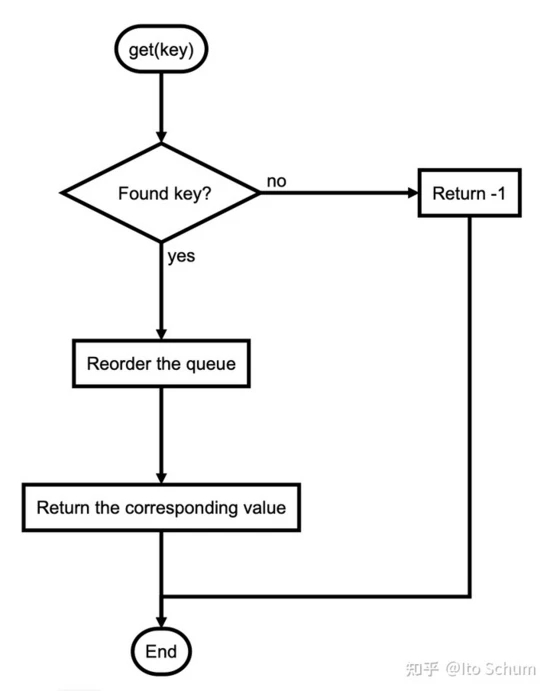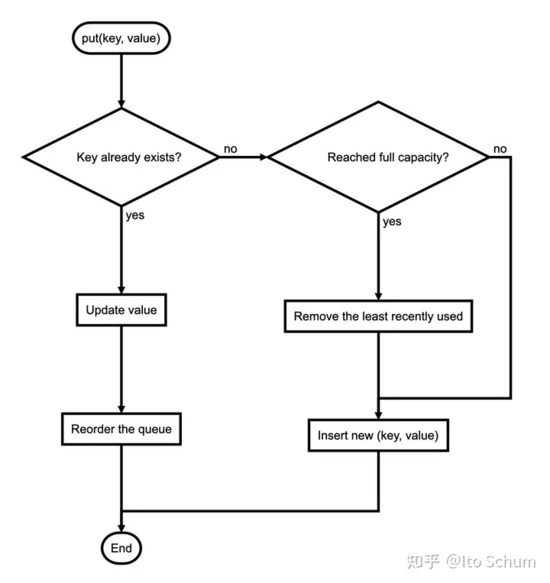这篇文章将为大家详细讲解有关C++如何实现LRU与LFU的缓存算法,小编觉得挺实用的,因此分享给大家做个参考,希望大家阅读完这篇文章后可以有所收获。
详见 LeetCode Q146
https:// leetcode.com/problems/l ru-cache/
https:// leetcode-cn.com/problem s/lru-cache/
问题描述:
LRUCache(int capacity) 以正整数作为容量 capacity 初始化 LRU 缓存
int get(int key) 如果关键字 key 存在于缓存中,则返回关键字的值,否则返回 -1 。
void put(int key, int value) 如果关键字已经存在,则变更其数据值;如果关键字不存在,则插入该组「关键字-值」。当缓存容量达到上限时,它应该在写入新数据之前删除最久未使用的数据值,从而为新的数据值留出空间。
在 O(1) 时间复杂度内完成这两种操作
所用数据结构:
为了使 get 与 put 操作的平均时间复杂度为 O(1) ,
使用双向链表 (STL list ) 储存缓存内容 (使用 STL pair {key, value} 表示),
使用哈希表 (STL unordered_map ) 储存 “key” 到 “pair iterator ” 的关系映射
typedef std::unordered_map<int, std::list<std::pair<int, int> >::iterator > CacheMap;
typedef std::list<std::pair<int, int> > LRUList;流程图:
get function

put function

代码实现:
#include <iostream>
#include <list>
#include <unordered_map>
typedef std::unordered_map<int, std::list<std::pair<int, int> >::iterator > CacheMap;
typedef std::list<std::pair<int, int> > LRUList;
class LRUCache {
public:
LRUCache(int capacity) {
_capacity = capacity;
}
int get(int key) {
CacheMap::iterator cache_itr = _cacheMap.find(key);
if (cache_itr == _cacheMap.end() ) {
return -1;
}
makeMostRecent(key, _cacheMap[key]->second);
LRUList::iterator list_itr = _LRUList.end();
--list_itr;
return list_itr->second;
}
void put(int key, int value) {
if (_cacheMap.find(key) != _cacheMap.end()) {
makeMostRecent(key, value);
return;
}
if (_LRUList.size() >= _capacity) {
removeLeastRecentTask(key);
}
addMostRecentTask(key, value);
}
private:
void makeMostRecent(int key, int value) {
_LRUList.erase(_cacheMap[key]);
_LRUList.push_back(std::make_pair(key, value) );
LRUList::iterator list_itr = _LRUList.end();
_cacheMap[key] = --list_itr;
}
void removeLeastRecentTask(int key) {
int keyToRemove = _LRUList.begin()->first;
_LRUList.erase(_LRUList.begin());
_cacheMap.erase(keyToRemove);
}
void addMostRecentTask(int key, int value) {
_LRUList.push_back(std::make_pair(key, value) );
LRUList::iterator list_itr = _LRUList.end();
_cacheMap[key] = --list_itr;
}
int _capacity;
LRUList _LRUList;
CacheMap _cacheMap;
};
// n = item number of the LRU list, aka capacity
// Time: O(1)
// Space: O(n)运行测试:
Accepted
22/22 cases passed (412 ms)
Your runtime beats 69.45 % of cpp submissions
Your memory usage beats 48.08 % of cpp submissions (174 MB)
详见 LeetCode Q460
https:// leetcode.com/problems/l fu-cache/
https:// leetcode-cn.com/problem s/lru-cache/
问题描述:
LFUCache(int capacity) - 用数据结构的容量 capacity 初始化对象
int get(int key) - 如果键存在于缓存中,则获取键的值,否则返回 -1 。
void put(int key, int value) - 如果键已存在,则变更其值;如果键不存在,请插入键值对。当缓存达到其容量时,则应该在插入新项之前,使最不经常使用的项无效。在此问题中,当存在平局(即两个或更多个键具有相同使用频率)时,应该去除 最近最久未使用的键。
「项的使用次数」就是自插入该项以来对其调用 get 和 put 函数的次数之和。使用次数会在对应项被移除后置为 0 。
为了确定最不常使用的键,可以为缓存中的每个键维护一个 使用计数器 。使用计数最小的键是最久未使用的键。
当一个键首次插入到缓存中时,它的使用计数器被设置为 1 (由于 put 操作)。对缓存中的键执行 get 或 put 操作,使用计数器的值将会递增。
所用数据结构:
为了使 get 与 put 操作的平均时间复杂度为 O(1) ,
使用哈希表 (STL unordered_map ) 储存 “key” 到 “value 与 frequency” 的关系映射 (使用 STL pair {value, frequency} 表示)
使用哈希表 (STL unordered_map ) 储存 “frequency” 到 “对应所有的 key” 的关系映射 (key 使用双向链表,即 STL list 存储)
使用哈希表 (STL unordered_map ) 储存 “key” 到 “2 中存储 key 所用 list 中对应 iterator ” 的关系映射
std::unordered_map<int, std::pair<int, int> > _keyToValFreq;
std::unordered_map<int, std::list<int> > _freqToKeyList;
std::unordered_map<int, std::list<int>::iterator> _keyToKeyListItr;流程图:
get function

put function

代码实现:
#include <iostream>
#include <list>
#include <unordered_map>
class LFUCache {
public:
LFUCache(int capacity) {
_capacity = capacity;
}
int get(int key) {
// If key doesn't exist
if (_keyToValFreq.find(key) == _keyToValFreq.end() ) {
return -1;
}
// if key exists, increse frequency and reorder
increaseFreq(key);
return _keyToValFreq[key].first;
}
void put(int key, int value) {
if (_capacity <= 0) { return; }
// if key exists
if (_keyToValFreq.find(key) != _keyToValFreq.end() ) {
_keyToValFreq[key].first = value;
increaseFreq(key);
return;
}
// if key doesn't exist
// if reached hashmap's max capacity, remove the LFU (LRU if tie)
if (_keyToValFreq.size() >= _capacity) {
int keyToRmove = _freqToKeyList[_minFreq].back();
_freqToKeyList[_minFreq].pop_back();
_keyToKeyListItr.erase(keyToRmove);
_keyToValFreq.erase(keyToRmove);
}
// Then add new item with frequency = 1
addNewTask(key, value);
}
void increaseFreq(int key) {
// Update the freq in the pair
int oldFreq = _keyToValFreq[key].second++;
// Detele the old freq by itr
_freqToKeyList[oldFreq].erase(_keyToKeyListItr[key]);
// Add the new freq and re-assign the itr
_freqToKeyList[oldFreq + 1].emplace_front(key);
_keyToKeyListItr[key] = _freqToKeyList[oldFreq + 1].begin();
// Update minFreq
if (_freqToKeyList[_minFreq].empty() ) {
_minFreq = oldFreq + 1;
}
}
void addNewTask(int key, int value) {
// Add new key-value/freq to all hashmaps
_minFreq = 1;
_keyToValFreq[key] = std::make_pair(value, _minFreq);
_freqToKeyList[_minFreq].emplace_front(key);
_keyToKeyListItr[key] = _freqToKeyList[_minFreq].begin();
}
private:
int _capacity;
int _minFreq;
std::unordered_map<int, std::pair<int, int> > _keyToValFreq;
std::unordered_map<int, std::list<int> > _freqToKeyList;
std::unordered_map<int, std::list<int>::iterator> _keyToKeyListItr;
};
// n = item number of the LFU, aka capacity
// Time: O(1)
// Space: O(n)运行测试:
Accepted
24/24 cases passed (464 ms)
Your runtime beats 72.37 % of cpp submissions
Your memory usage beats 45.99 % of cpp submissions (186.7 MB)
关于“C++如何实现LRU与LFU的缓存算法”这篇文章就分享到这里了,希望以上内容可以对大家有一定的帮助,使各位可以学到更多知识,如果觉得文章不错,请把它分享出去让更多的人看到。
亿速云「云服务器」,即开即用、新一代英特尔至强铂金CPU、三副本存储NVMe SSD云盘,价格低至29元/月。点击查看>>
免责声明:本站发布的内容(图片、视频和文字)以原创、转载和分享为主,文章观点不代表本网站立场,如果涉及侵权请联系站长邮箱:is@yisu.com进行举报,并提供相关证据,一经查实,将立刻删除涉嫌侵权内容。